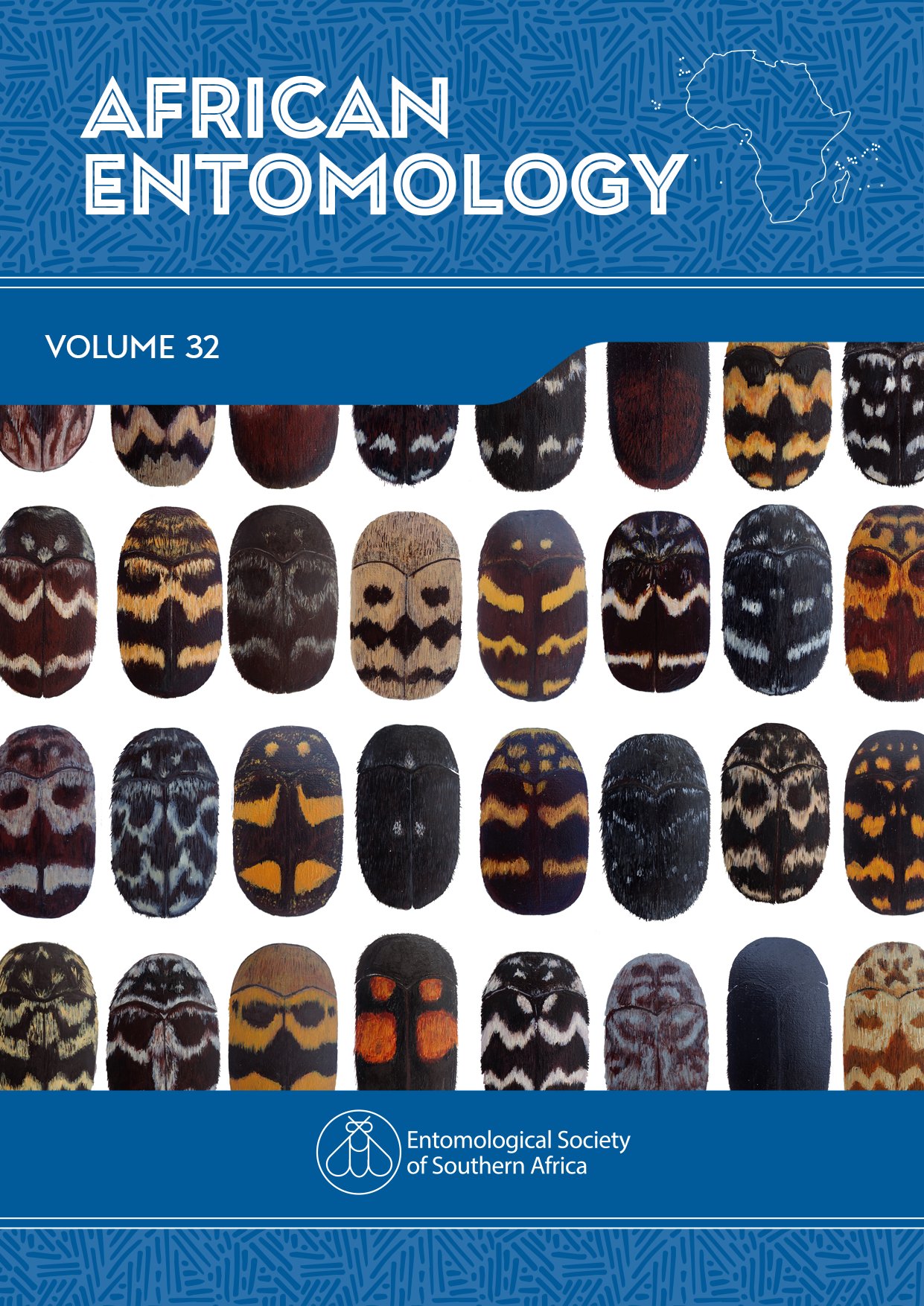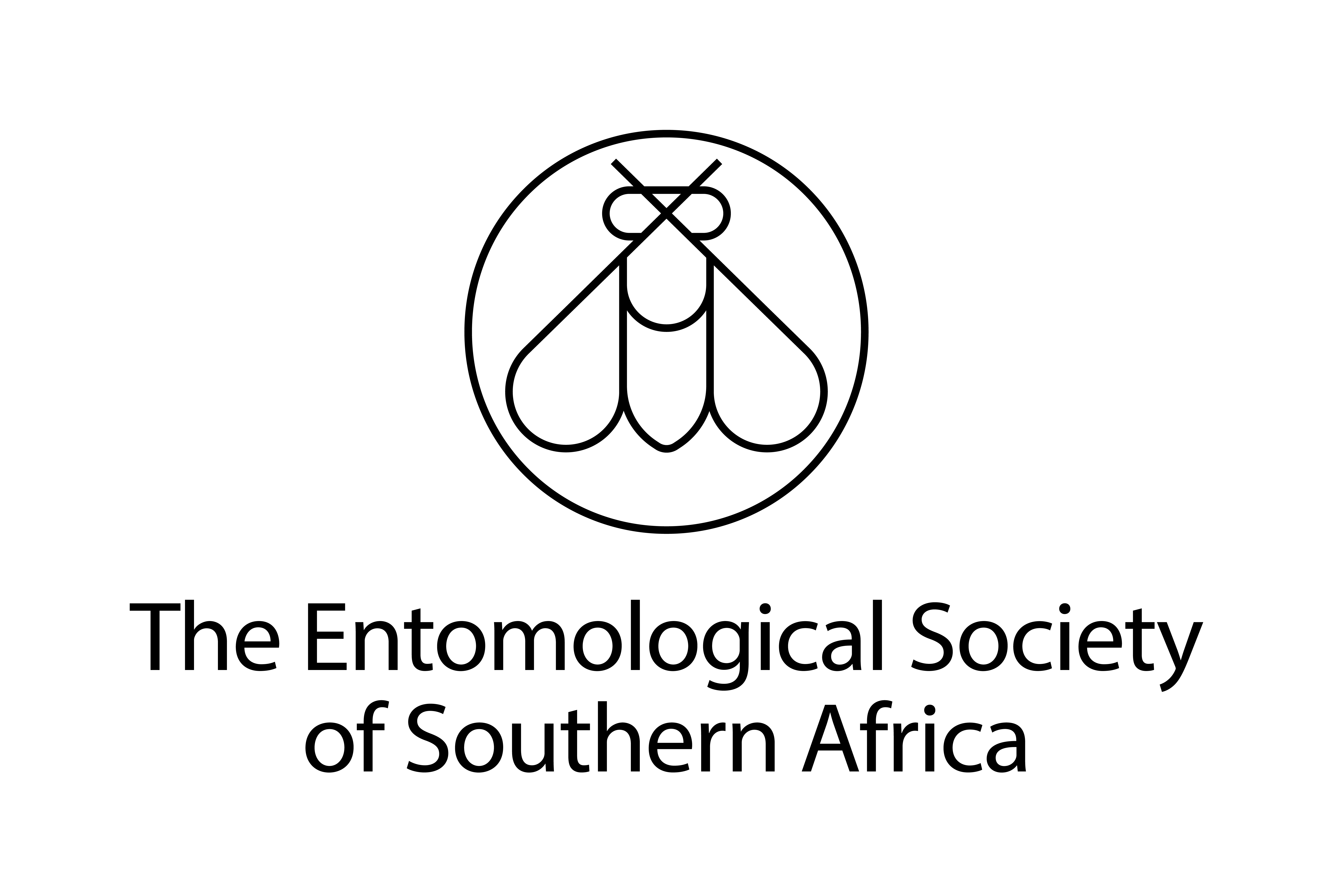Biotic resistance towards Hydrellia egeriae, a biological control agent for the aquatic weed Egeria densa, in South Africa
DOI:
https://doi.org/10.17159/2254-8854/2024/a15718Keywords:
Braconidae, Ephydridae, parasitism, submerged aquatic weed, antagonism, HydrocharitaceaeAbstract
Egeria densa is a submerged aquatic weed that can grow into dense monocultures in rivers and dams in South Africa, which negatively affects ecosystem functioning and services. The biological control agent Hydrellia egeriae Rodrigues-Júnior (Diptera: Ephydridae) was first released against Egeria densa Planchon (Hydrocharitaceae) in South Africa in 2018. Biotic resistance in an introduced range can have negative impacts on the ability of a biological control agent to establish and exert top-down pressure. Dipteran and lepidopteran species that are used as biological control agents are often susceptible to higher levels of parasitism in their introduced range than biological control agents from other insect orders. In addition, ecological analogues that are present in South Africa, make H. egeriae particularly vulnerable to biotic resistance. Considering this, post-release surveys were conducted to investigate if native parasitoids will extend their host range to include H. egeriae. Chaenusa seminervata van Achterberg, C. anervata van Achterberg (Braconidae: Alysiinae: Dacnusini) and Ademon lagarosiphonae van Achterberg (Braconidae: Opiinae) were reared from field-collected H. egeriae pupae, within a year of its release. These braconid parasitoids were previously recorded from a native herbivore, Hydrellia lagarosiphon Deeming (Diptera: Ephydridae). Parasitism levels of H. egeriae ranged from 50 to 74% in cold months and 0 to 60% in warmer months, with higher levels of parasitism at a site where H. lagarosiphon naturally occurs. This study also found that cumulative release events of the biological control agent increase the probability of parasitism of field populations, by directly increasing the host pool. However, biological control efficacy can potentially be increased by limiting release efforts to a maximum of two release events per site per season, with particular focus on releasing in warm (i.e. spring/summer) months. Continued post-release surveys are necessary to not only monitor H. egeriae’s impact on E. densa, but also to obtain a better understanding of seasonal parasitism levels across E. densa-invaded sites in South Africa.
Downloads
References
Bess HA, Haramoto FH. 1959. Biological control of Pamakani, Eupatorium adenophorum, in Hawaii by a tephritid gall fly, Procecidochares utilis. 2. Population studies of the weed, the fly, and the parasites of the fly. Ecology. 40(2):244–249. https://doi.org/10.2307/1930034.
Cabrera Walsh G, Magalí Dalto Y, Mattioli FM, Carruthers RI, Anderson LW. 2013. Biology and ecology of Brazilian elodea (Egeria densa) and its specific herbivore, Hydrellia sp., in Argentina. BioControl 58: 133–147. https://doi.org/10.1007/s10526-012-9475-x.
Coetzee JA, Bownes A, Martin GD, Miller BE, Smith R, Weyl PSR, Hill MP. 2021. A review of the biocontrol programmes against aquatic weeds in South Africa. African Entomology 29(3): 935–964. https://doi.org/10.4001/003.029.0935.
Cook CDK, Urmi-König K. 1984. A revision of the genus Egeria (Hydrocharitaceae). Aquatic Botany 19: 73–96. https://doi.org/10.1016/0304-3770(84)90009-3.
Coon BR, Harms NE, Cuda JP, Grodowitz MJ. 2014. Laboratory biology and field population dynamics of Trichopria columbiana (Hymenoptera: Diapriidae), an acquired parasitoid of two hydrilla biological control agents. Biocontrol Science and Technology 24(11): 1243–1264. https://doi.org/10.1080/09583157.2014.933311.
Cornell HV, Hawkins BA. 1993. Accumulation of native parasitoid species on introduced herbivores: A comparison of hosts as natives and hosts as invaders. The American Naturalist 141(6): 847–865. https://doi.org/10.1086/285512.
Deonier DL. 1971. A systematic and ecological study of Nearctic Hydrellia (Diptera: Ephydridae). Smithsonian Contributions to Zoology 68: 1–147. https://doi.org/10.5479/si.00810282.68.
Godfray CJ, Agassiz DJL, Nash DR, Lawton J. 1995. The recruitment of parasitoid species to two invading herbivores. Journal of Animal Ecology 64: 393–402. https://doi.org/10.2307/5899.
Goeden RD, Louda SM. 1976. Biotic interference with insects imported for weed control. Annual Review of Entomology 21: 325–342. https://doi.org/10.1146/annurev.en.21.010176.001545.
Goulet H, Huber JT. 1995. Hymenoptera of the world: an identification guide to families. Research Branch, Agriculture Canada. Ottawa, Ontario. 680 pp. https://doi.org/10.1002/mmnd.19950420212.
Haramoto T, Ikusima I. 1988. Life cycle of Egeria densa Planch., an aquatic plant naturalized in Japan. Aquatic Botany 30: 389–403. https://doi.org/10.1016/0304-3770(88)90070-8.
Hartig F. 2022. DHARMa: Residual diagnostics for hierarchical (Multi-Level / Mixed) Regression Models. R package version 0.4.6. https://CRAN.R-project.org/package=DHARMa.
Hawkins BA. 1993. Species richness, host mortality, and biological control. The American Naturalist 141(4): 634–641. https://doi.org/10.1086/285495.
Heimpel GE, Mills N. 2017. Biological control: Ecology and Applications. Cambridge: Cambridge University Press. 386 pp. https://doi.org/10.1017/9781139029117.
Hill MP, Hulley PE. 1995. Host range extension by native parasitoids to weed biocontrol agents introduced to South Africa. Biological Control 5: 297–302. https://doi.org/10.1006/bcon.1995.1037.
Hill MP, Coetzee JA. 2020. Chapter 20. How can progress in the understanding of antagonistic interactions be applied to improve biological control of plant invasions? In: Traveset A, Richardson DM, editors. Plant Invasions: The Role of Biotic Interactions. Wallingford: CABI. pp 363–374. http://dx.doi.org/10.1079/9781789242171.0020.
Katzenberger J, Zacharias D. 2015. Mutualism of Stratiotes aloides L. (Hydrocharitaceae) and Hydrellia tarsata Haliday (Diptera: Ephydridae): tritrophic interaction of macrophyte, leaf-mining dipteran pollinator and parasitoid Braconidae. Journal of Pollination Ecology 15(4): 23–29. https://doi.org/10.26786/1920-7603(2015)3.
Keane RM, Crawley MJ. 2002. Exotic plant invasions and the enemy release hypothesis. Trends in Ecology and Evolution. 17(4): 164–170. http://dx.doi.org/10.1016/S0169-5347(02)02499-0.
Kelly DW, Paterson RA, Townsend CR, Poulin R, Tompkins DM. 2009. Parasite spillback: A neglected concept in invasion ecology? Ecology 90(8): 2047–2056. http://dx.doi.org/10.1890/08-1085.1.
Kula RR, Martinez JJ, Cabrera Walsh G. 2009. Supplement to revision of New World Chaenusa Haliday Sensu Lato (Hymenoptera: Braconidae: Alysiinae). Proceedings of the Entomological Society of Washington 111(3): 641–655. https://doi.org/10.4289/0013-8797-111.3.641.
Mangan R, Carolan JC, Baars JR. 2019. Molecular characterization of Hydrellia lagarosiphon, a leaf-mining biological control agent for Lagarosiphon major, reveals weak variance across large geographic areas in South Africa. Biological Control. 132: 8–15. http://dx.doi.org/10.1016/j.biocontrol.2019.01.017.
Martin GD, Coetzee JA, Baars JR. 2013. Hydrellia lagarosiphon Deeming (Diptera: Ephydridae), a potential biological control agent for the submerged aquatic weed, Lagarosiphon major (Ridley) Moss (Hydrocharitaceae). African Entomology 21(1): 151–160. http://dx.doi.org/10.4001/003.021.0118.
Mazzeo N, Rodríguez-Gallego L, Kruk C, Meerhoff M, Gorga J, Lacerot G, Quintans F, Loureiro M, Larrea D, García-Rodríguez F. 2003. Effects of Egeria densa Planch. beds on a shallow lake without piscivorous fish. Hydrobiologia 506-509(1-3): 591–602.
McFadyen R, Spafford Jacob H. 2003. Insects for the biocontrol of weeds: predicting parasitism levels in the new country. In: Cullen JM, Briese DT, Kriticos DJ, Lonsdale WM, Morin L, Scott JK. (Eds.) Proceedings of the XI International Symposium on Biological Control of Weeds. Canberra: CSIRO Entomology. pp. 135–140.
Paynter Q, Fowler SV, Hugh-Gourlay A, Groenteman R, Peterson PG, Smith L, Winks CJ. 2010. Predicting parasitoid accumulation on biological control agents of weeds. Journal of Applied Ecology 47: 575–582. https://doi.org/10.1111/j.1365-2664.2010.01810.x.
Paynter Q, Paterson ID, Kwong RM. 2020. Predicting non-target impacts. Current Opinion in Insect Science. 38: 79-83. https://doi.org/10.1016/j.cois.2020.02.002.
R Core Team. 2022. R: a language and environment for statistical computing. R foundation for statistical computing, Vienna, Austria. https:// www.R-project.org/.
Schulz AN, Lucardi RD, Marsico TD. 2019. Successful invasion and failed biocontrol: The role of antagonistic species interactions. BioScience 69(9): 711–724. https://doi.org/10.1093/biosci/biz075.
Smith R, Coetzee JA, Hill MP. 2022. Best of both worlds: the thermal physiology of Hydrellia egeriae, a biological control agent for the submerged aquatic weed, Egeria densa in South Africa. BioControl 67(3): 365–374. https://doi.org/10.1007/s10526-022-10142-w.
Smith R, Mangan R, Coetzee JA. 2019. Risk assessment to interpret the physiological host range of Hydrellia egeriae, a biocontrol agent for Egeria densa. BioControl. 64: 447–456. http://dx.doi.org/10.1007/s10526-019-09942-4.
Stiling PD, Brodbeck BV, Strong DR. 1984. Intraspecific competition in Hydrellia valida (Diptera: Ephydridae), a leaf-miner of Spartina alterniflora. Ecology. 65(2): 660–662. https://doi.org/10.2307/1941431.
van Achterberg C, Prinsloo GL. 2012. Braconidae (Hymenoptera: Opiinae, Alysiinae) reared from aquatic leaf-mining Diptera on Lagarosiphon major (Hydrocharitaceae) in South Africa. African Entomology. 20(1): 124–133. https://hdl.handle.net/10520/EJC119297.
van Klinken RD, Burwell CJ. 2005. Evidence from a gelechiid leaf-tier on mesquite (Mimosaceae: Prosopis) that semi-concealed lepidopteran biological control agents may not be at risk from parasitism in Australian rangelands. Biological Control 32(1): 121–129. https://doi.org/10.1016/j.biocontrol.2004.09.001.
van Noort S, Smith R, Coetzee JA. 2021. Identity of parasitoid wasps (Hymenoptera: Braconidae and Eulophidae) reared from aquatic leaf-mining flies (Diptera: Ephydridae) on invasive Brazilian waterweed Egeria densa in South Africa. African Invertebrates 62(1): 287–314. https://doi.org/10.3897/afrinvertebr.62.62842.
Winston RL, Schwarzlander M, Hinz HL, Day MD, Cock MJW, Julien MH, Eds. 2023. Biological Control of Weeds: A World Catalogue of Agents and Their Target Weeds. Based on FHTET-2014-04, USDA Forest Service, Forest Health Technology Enterprise Team. Available online at https://www.ibiocontrol.org/catalog/ [Accessed 07 December 2023].
Downloads
Published
Issue
Section
License
Copyright (c) 2024 Rosali Moffat, Simon van Noort, Julie Coetzee, Martin Hill

This work is licensed under a Creative Commons Attribution 4.0 International License.




.png)